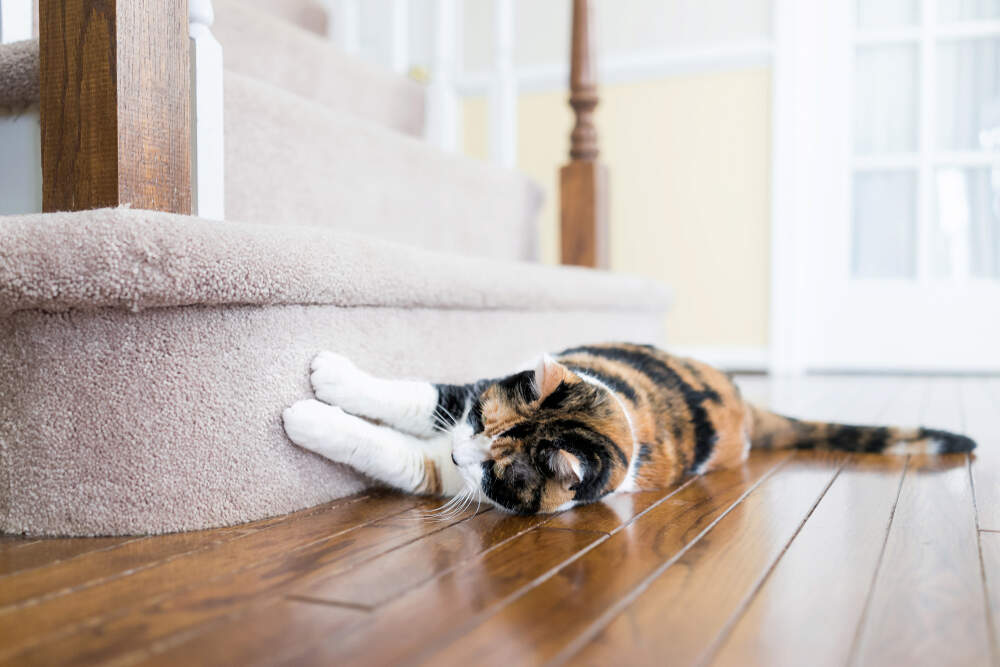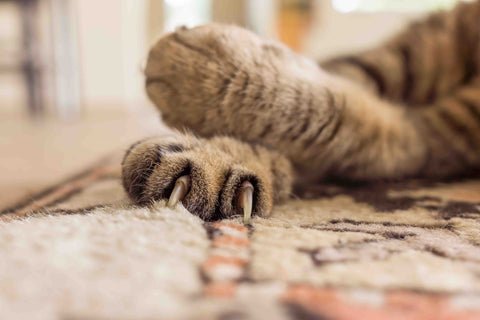As an Amazon Associate I earn from qualifying purchases.
Cats love to scratch. It’s natural for them.
But, it can ruin your carpet. So, how can you stop this behavior? Cats scratch to mark territory, sharpen claws, or stretch. While it’s a normal activity, it becomes a problem when your carpet is the target. Luckily, there are ways to redirect this behavior.
Understanding why your cat scratches is the first step. After that, you can take practical measures to save your carpet. This includes providing alternatives and discouraging carpet scratching. Let’s explore simple, effective methods to keep both your cat and carpet happy.
Identify The Cause
To stop your cat from scratching the carpet, first identify the cause. Knowing why your cat scratches can help you find the right solution.
Behavioral Reasons
Cats often scratch due to behavioral reasons. They might scratch to mark their territory. Scratching leaves both a visual mark and a scent. This tells other cats that the area is claimed. Cats also scratch to stretch their muscles. It helps them feel good and stay agile. If your cat is bored, it might scratch to release pent-up energy.
Another reason might be stress. Changes in the home or new pets can make your cat anxious. Scratching can be a way for them to cope. Providing a scratching post or toys can reduce this behavior.
Medical Issues
Sometimes, medical issues cause cats to scratch the carpet. If your cat has a medical problem, it might scratch due to discomfort. Conditions like arthritis or skin allergies can make your cat scratch more. It’s important to observe if your cat’s scratching is paired with other symptoms. Signs like limping, excessive grooming, or hair loss can indicate a medical issue.
In such cases, visit a vet to rule out health problems. Treating the medical issue can stop the scratching. Always ensure your cat is healthy and comfortable.

Credit: www.amazon.com
Provide Alternatives
Cats love to scratch. It’s natural for them. But this can damage your carpet. Providing alternatives can save your floors. Giving your cat proper items to scratch is key.
Scratching Posts
Scratching posts are essential. They give cats a place to scratch. Choose a post taller than your cat. This allows a full stretch. Covered in sisal rope is best. It’s rough and durable.
Place the post where your cat scratches most. This helps redirect their behavior. Sprinkle some catnip on the post. This makes it more attractive.
Cat Trees
Cat trees are more than just scratching posts. They offer multiple levels. Your cat can climb, scratch, and lounge.
Look for trees with sisal-covered areas. These are perfect for scratching. Ensure the tree is stable. A wobbly tree won’t be used. Place it in a room your cat frequents. This makes it more appealing.
Cat trees also provide exercise. They keep your cat active and happy.
Use Deterrents
To stop your cat from scratching the carpet, you can use various deterrents. These deterrents will help redirect your cat’s scratching behavior to more appropriate surfaces. Let’s explore some effective deterrent methods.
Double-sided Tape
Applying double-sided tape to areas where your cat scratches can be very effective. Cats dislike the sticky texture on their paws. This can discourage them from scratching the carpet. Place the tape on spots your cat frequently targets.
Here’s a simple way to apply it:
- Identify the areas where your cat scratches.
- Clean the surface to ensure the tape sticks well.
- Cut strips of double-sided tape and place them on the carpet.
This method works because cats find the stickiness uncomfortable. Over time, they will avoid those areas.
Citrus Spray
Cats generally dislike the smell of citrus. You can use a citrus spray to deter them from scratching the carpet. You can buy a commercial citrus spray or make your own at home.
Here’s how to make a DIY citrus spray:
- Mix water with lemon or orange essential oil.
- Pour the mixture into a spray bottle.
- Spray it lightly on the carpet areas.
This natural method can help keep your cat away from the carpet. Reapply the spray regularly for the best results.
Regular Nail Trimming
Regular nail trimming is essential to stop your cat from scratching the carpet. By trimming your cat’s nails, you reduce the damage they can cause. This practice also keeps your cat comfortable and healthy.
Tools Required
To trim your cat’s nails, you will need the following tools:
- Cat Nail Clippers: Choose clippers designed for cats. They are safer and easier to use.
- Styptic Powder: This helps stop bleeding if you accidentally cut the quick.
- Treats: Use treats to reward your cat and make the process positive.
Trimming Techniques
Follow these steps to trim your cat’s nails effectively:
- Prepare the Area: Find a quiet, well-lit space. Gather all your tools in advance.
- Handle the Paws: Gently hold your cat’s paw. Press the pad to extend the nails.
- Identify the Quick: The quick is the pink part inside the nail. Avoid cutting it.
- Trim the Tip: Use the clippers to cut the sharp tip of the nail. Cut only the white part.
- Reward Your Cat: Give your cat a treat and praise them. This makes the experience positive.
Repeat this process every few weeks. Regular trimming reduces the urge to scratch carpets.
Cover The Carpet
Is your cat constantly scratching your carpet? This can be frustrating. One effective solution is to cover the carpet. This helps protect it and deters your cat from scratching. Here are some ways to do that.
Rugs And Mats
Use rugs or mats to cover high-traffic areas. Place them over spots your cat likes to scratch. Choose rugs with sturdy materials. Sisal or jute rugs work well. They provide a similar texture to what cats enjoy. This can divert their scratching from the carpet.
Furniture Placement
Rearrange your furniture to cover the carpet. Place heavy furniture over frequently scratched spots. This makes those areas inaccessible to your cat. Move sofas, tables, or chairs. The new layout can confuse your cat. It might reduce their scratching behavior.

Credit: www.comfortzone.com
Create A Play Area
Creating a play area for your cat can help stop carpet scratching. Cats scratch to mark territory and to keep their claws healthy. Providing a dedicated space for play can satisfy these needs. This can also keep your carpet safe. Here are some ways to create an engaging play area.
Interactive Toys
Interactive toys can keep your cat entertained. Toys that move or make noise can capture their attention. Battery-operated mice or feather wands are great options. Puzzle feeders also work well. These toys engage your cat’s mind and body. They can reduce boredom and prevent carpet scratching.
Climbing Structures
Cats love to climb and explore. Adding climbing structures can redirect their scratching habits. Cat trees and shelves are perfect choices. Place them in areas where your cat likes to spend time. Make sure they are sturdy and safe. This gives your cat a place to scratch and climb. It helps keep them away from your carpet.
Positive Reinforcement
Positive reinforcement is a powerful method to stop your cat from scratching the carpet. By rewarding good behavior, you can train your cat to use alternatives like scratching posts. This approach encourages your cat to repeat the desired behavior.
Reward Good Behavior
Whenever your cat uses a scratching post, give a treat. Praise your cat with a gentle voice. This tells your cat they did something right. Over time, your cat will prefer the scratching post. Remember, timing is key. Reward immediately after the good behavior.
Training Sessions
Set aside time for short training sessions. Focus on teaching your cat to use the scratching post. Use toys to guide your cat to the post. Once your cat scratches the post, reward them. Repeat this daily. Consistency is important in training your cat. Patience and practice will yield results.

Credit: www.feliway.co.uk
Consult A Professional
One effective way to stop your cat from scratching the carpet is to consult a professional. Professionals can offer tailored advice and solutions that fit your cat’s specific needs. This approach can save you time and stress.
Veterinarian Advice
A veterinarian can provide valuable insights into your cat’s behavior. Sometimes, scratching can indicate an underlying health issue.
- Health Check: Ensure there are no medical reasons for the scratching.
- Nutritional Needs: Proper diet can affect your cat’s behavior.
- Environmental Changes: Your vet may suggest changes to your home environment.
Behavior Specialist
If your vet rules out health issues, a behavior specialist can help. These experts focus on understanding and modifying feline behavior.
- Behavioral Assessment: They will assess your cat’s behavior to identify triggers.
- Customized Plan: They provide a plan tailored to your cat’s needs.
- Follow-up Support: Ongoing support to ensure the plan’s success.
Both veterinarians and behavior specialists can offer effective solutions to stop your cat from scratching the carpet. Professional advice is often the best way to address complex behavior issues.
Frequently Asked Questions
How Can I Stop My Cat From Scratching The Carpet?
To stop your cat from scratching the carpet, use scratching posts and pads. Place them near the areas your cat scratches most. Reward your cat with treats for using them.
Why Does My Cat Scratch The Carpet?
Cats scratch the carpet to mark territory and keep their claws healthy. It’s a natural behavior for cats.
Are There Sprays To Deter Cat Scratching?
Yes, there are sprays that can deter cats from scratching. Look for pet-safe deterrent sprays at pet stores.
Can Trimming My Cat’s Nails Help?
Trimming your cat’s nails can reduce the damage caused by scratching. Trim them regularly to keep them short and blunt.
Conclusion
Stopping your cat from scratching the carpet is possible. Provide alternatives like scratching posts. Reward good behavior with treats. Use deterrents on the carpet. Keep your cat’s claws trimmed. Engage your cat with toys and activities. Consistency is key. Patience helps in training.
Soon, your carpet will be safe from scratches. Your cat will be happier too. Keep these tips in mind. Enjoy a scratch-free home.
As an Amazon Associate, I earn from qualifying purchases.


